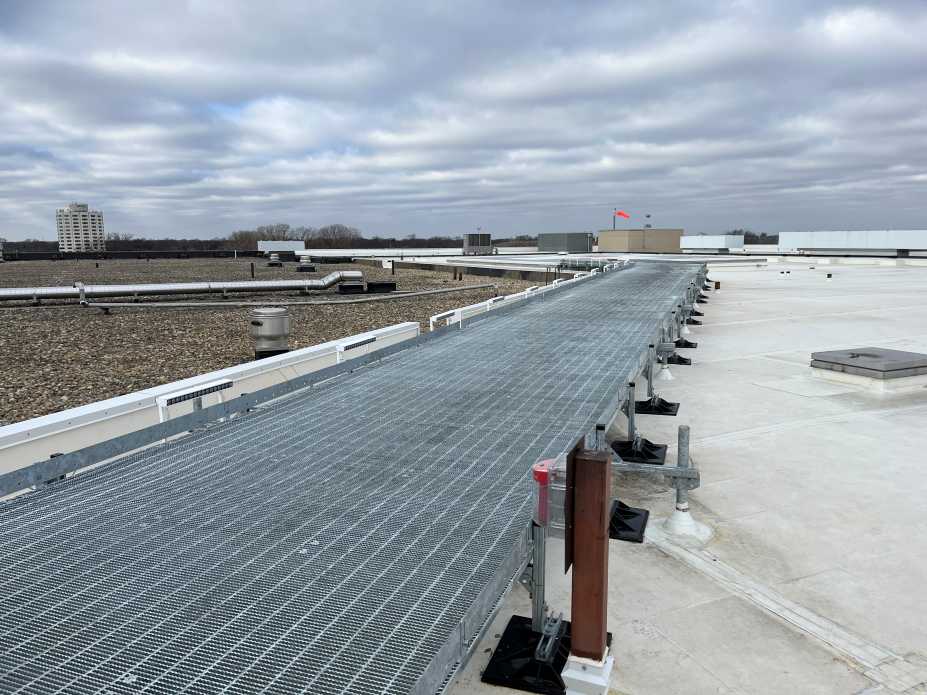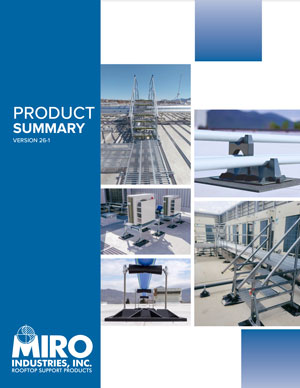Modern commercial and industrial buildings rely on a variety of rooftop systems, including HVAC units, ductwork, electrical conduit, and solar installations. Maintaining these systems safely and efficiently requires dependable access solutions. Well-designed rooftop walkway systems make this possible by creating safe, stable paths for maintenance personnel while protecting the roof surface from damage.
A rooftop walkway system is more than a convenience. It is an essential safety and maintenance feature that supports compliance, reduces long-term costs, and enhances the overall functionality of the roof.
What Are Rooftop Walkway Systems?
Rooftop walkway systems comprise elevated or surface-mounted paths that enable workers to move safely across the roof without stepping directly on the membrane. These walkways distribute weight evenly and minimize wear, reducing the likelihood of punctures or tears.
Walkway systems can be standalone installations or integrated with rooftop platforms and roof catwalk systems to create a complete access network. This ensures safe movement across complex rooftop layouts, including over pipes, ducts, and uneven surfaces.
Why Rooftop Walkway Systems Are Essential
Regular rooftop maintenance is unavoidable, whether it involves servicing HVAC units, inspecting solar panels, or checking ductwork. Without designated walkways, workers risk damaging the roof membrane and compromising waterproofing.
A well-planned rooftop walkway system offers several key benefits:
- Enhanced safety: Provides a stable, anti-slip surface for safe movement across the roof.
- Roof protection: Prevents foot traffic from damaging the membrane or insulation.
- Code compliance: Meets OSHA and local regulations for rooftop access and fall protection.
- Efficiency: Defines clear routes between service areas for faster, safer maintenance.
Planning and Layout Design
Designing an effective rooftop walkway system begins with understanding the roof layout and its intended use. Start by identifying all areas that require routine access, such as air handling units, vents, or solar inverters. Then map out the most direct and safe routes between them.
A well-planned system should minimize travel distance while avoiding obstacles like pipes or conduit lines. In many cases, roof walkways are installed alongside rooftop platforms or extended with a roof catwalk system to provide full coverage across the roof.
When planning the layout, consider:
- Roof slope, drainage, and elevation changes
- Equipment spacing and service zones
- The number of personnel who will use the walkway
- The need for stairs, guardrails, or handrails for elevation changes
Thorough layout planning helps ensure a smooth workflow while maintaining compliance and safety.
Material and Design Considerations
Choosing the right materials is critical to ensure durability and safety. Common materials for rooftop walkway systems include aluminum, galvanized steel, and fiberglass-reinforced plastic (FRP).
Aluminum is lightweight, corrosion-resistant, and ideal for rooftops with strict load limits.
Galvanized steel provides excellent strength for high-traffic or industrial environments.
FRP is best suited for corrosive or coastal environments due to its UV and chemical resistance.
Regardless of the material, walkways should feature anti-slip grating to maintain traction in wet or icy conditions. They should also be modular, allowing for easy reconfiguration or extension as rooftop layouts evolve.
Non-Penetrating Design and Roof Protection
The best rooftop walkway systems use non-penetrating bases that rest directly on the roof membrane. This design avoids drilling or fastening into the surface, which could lead to leaks or void the roof warranty. Instead, the system relies on evenly distributed weight and rubber or composite bases that grip the roof securely.
Non-penetrating systems also make installation faster and less disruptive, since no additional sealing or structural modification is required. They are compatible with most roof types, including single-ply, modified bitumen, and built-up roofs.
Safety and Compliance Standards
Safety is at the heart of every rooftop walkway system. All systems must comply with OSHA and local building codes for fall protection, load capacity, and walking surface requirements.
Key safety features to include:
- Guardrails and handrails on elevated areas
- Slip-resistant treads or open grating for water drainage
- Consistent step height and spacing on stairs or transitions
- Clear width for personnel and equipment movement
- Toe boards in areas where tools or debris might fall
Properly engineered systems are designed to support not just foot traffic, but also the weight of tools, equipment, and materials used during maintenance work.
Integrating Catwalks and Platforms
A roof catwalk system is often a natural extension of a rooftop walkway. Catwalks provide raised access paths that allow personnel to move over obstacles like ducts, piping, or changes in elevation. These structures are especially useful on complex roofs where equipment is spread out or installed at varying heights.
Rooftop platforms can be added to provide level work areas around equipment that requires frequent service. Together, catwalks, platforms, and walkways form a comprehensive rooftop access solution that makes maintenance safer, faster, and more efficient.
By integrating these components, you can create a seamless system that connects every service area on the roof without compromising the membrane or structural integrity.
Installation and Maintenance
Rooftop walkway systems should be installed by qualified professionals familiar with roof structures and manufacturer specifications. Installers must ensure that bases are properly aligned, that load distribution is even, and that walkways are securely connected to platforms or catwalks where needed.
After installation, routine inspections help maintain system integrity. Check for loose connections, corrosion, or surface wear, and verify that the walkway bases remain stable on the roof. Scheduled maintenance ensures long-term safety and performance.
Long-Term Value and Performance
Investing in a rooftop walkway system offers long-term benefits for any building with rooftop equipment. It helps extend the life of the roof, minimizes safety risks, and creates a more organized, accessible environment for maintenance crews.
By combining rooftop walkways, catwalk systems, and rooftop platforms, you establish a complete access network that protects both your workers and your investment. A well-designed system turns the roof into a safe, functional workspace — one built for long-term performance and reliability.
—————————————————————————
MIRO is ready to assist you. Request a Quote or schedule a Free Rooftop Design Consultation for professional advice on the ideal support system tailored to your requirements.


